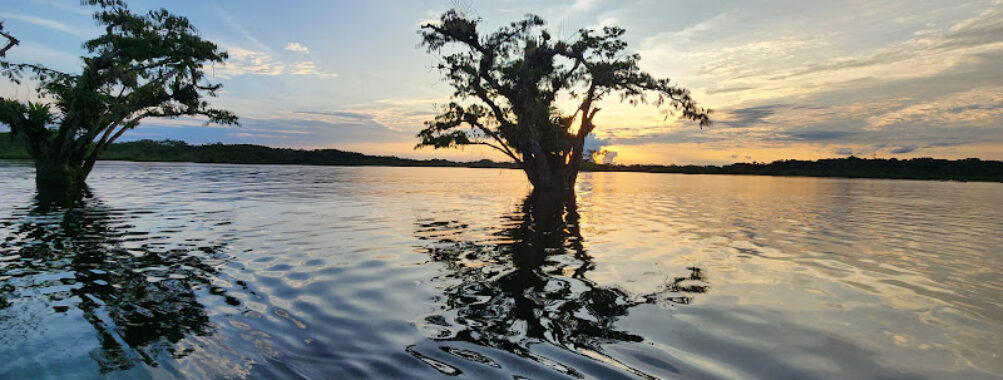
Reserva de producción de Fauna Cuyabeno
Table of Contents
Description
The Reserva de producción de Fauna Cuyabeno is an absolute marvel of nature that I was lucky enough to explore last year. This stunning protected area in Ecuador’s Amazon basin covers over 600,000 hectares of pristine rainforest and wetland ecosystems. Y’know what really blew my mind? The way the black-water rivers snake through the forest, creating this incredible network of lagoons that seem to go on forever.
The reserve is home to some of the most diverse wildlife I’ve ever encountered – we’re talking 500+ bird species, pink river dolphins (yes, they’re actually pink!), various monkey species, and even those peculiar-looking three-toed sloths. But what makes Cuyabeno truly special is how the ecosystem changes with the seasons. During the rainy season, the water levels rise dramatically, transforming the forest into this magical flooded wonderland where you can canoe right through the treetops!
Key Features
• 14 different lagoons, including the spectacular Great Lagoon of Cuyabeno
• 8 major indigenous communities who maintain their traditional way of life
• Over 500 species of birds (I counted at least 30 different ones during my visit!)
• 12 species of monkeys swinging through the canopy
• Pink and grey river dolphins that frequently surface in the lagoons
• More than 350 fish species swimming in the black waters
• Ancient kapok trees that tower over 40 meters high
• A mind-boggling variety of medicinal plants used by local communities
• Night-time caiman spotting opportunities (trust me, it’s both terrifying and exciting)
• Crystal-clear night skies perfect for stargazing when the weather cooperates
Best Time to Visit
I’ve gotta be straight with you – timing your visit to Cuyabeno can make or break your experience. The reserve has two distinct seasons, and each offers something unique. The rainy season (April to July) creates higher water levels, making it easier to navigate the lagoons and spot wildlife from your boat. But don’t let the name scare you – it doesn’t rain 24/7!
The drier season (August to March) has its own charm. Water levels drop, exposing beautiful beaches along the riversides where you might spot sunbathing caimans. Some of the smaller channels might become harder to navigate, but you’ll get more opportunities for hiking through the forest.
Personally, I’d recommend visiting during the transition periods (March-April or July-August) when you can experience a bit of both worlds. The temperatures hover around 25°C (77°F) year-round, so that’s one less thing to worry about!
How to Get There
Getting to Cuyabeno is part of the adventure, and I mean that in the best possible way! Most visitors start their journey from Quito or other major Ecuadorian cities. First, you’ll need to catch a flight or bus to Lago Agrio (also called Nueva Loja). From there, it’s about a 2-hour drive to the entrance of the reserve at the Puente Cuyabeno (Cuyabeno Bridge).
Here’s where it gets interesting – you’ll hop on a motorized canoe for a 2-3 hour journey downstream to reach your lodge. The boat ride itself is an amazing experience – keep your camera ready because you might spot wildlife before even reaching your destination!
Most people book their visits through tour operators who handle all the logistics. That’s definitely the way to go, as trying to arrange everything independently can be pretty challenging in this remote area.
Tips for Visiting
Alright, lemme share some hard-learned wisdom from my time in Cuyabeno. First off, pack light but smart. You’ll want quick-dry clothes (cotton takes forever to dry in the humidity), good rubber boots (most lodges provide these, but bring your own if you’re picky about footwear), and plenty of insect repellent.
Your electronics need special attention – bring waterproof bags for your camera and phone. The humidity here is no joke! And speaking of cameras, pack extra batteries and memory cards. You’ll be taking way more photos than you expect.
Don’t forget to bring cash – there are no ATMs in the reserve, and some of the indigenous communities sell beautiful handmade crafts that you might wanna take home.
Pro tip: book at least a 3-day tour. I initially thought 2 days would be enough, but man, was I wrong! There’s so much to see and experience that even 4-5 days wouldn’t feel too long.
And please, respect the local communities and their customs. Ask before taking photos of people, and consider bringing some school supplies to donate – the local schools can really use them.
Oh, and one last thing – stay flexible! Mother Nature runs the show here, and sometimes plans need to change because of weather or wildlife movements. But trust me, those unexpected moments often turn into the best stories!
Keep in mind that this is a pretty remote location, so pack any essential medications you might need. And while the local guides are incredibly knowledgeable, having a basic Spanish phrasebook handy can really enhance your experience.
Location
Places to Stay Near Reserva de producción de Fauna Cuyabeno
Find and Book a Tour
Explore More Travel Guides
No reviews found! Be the first to review!